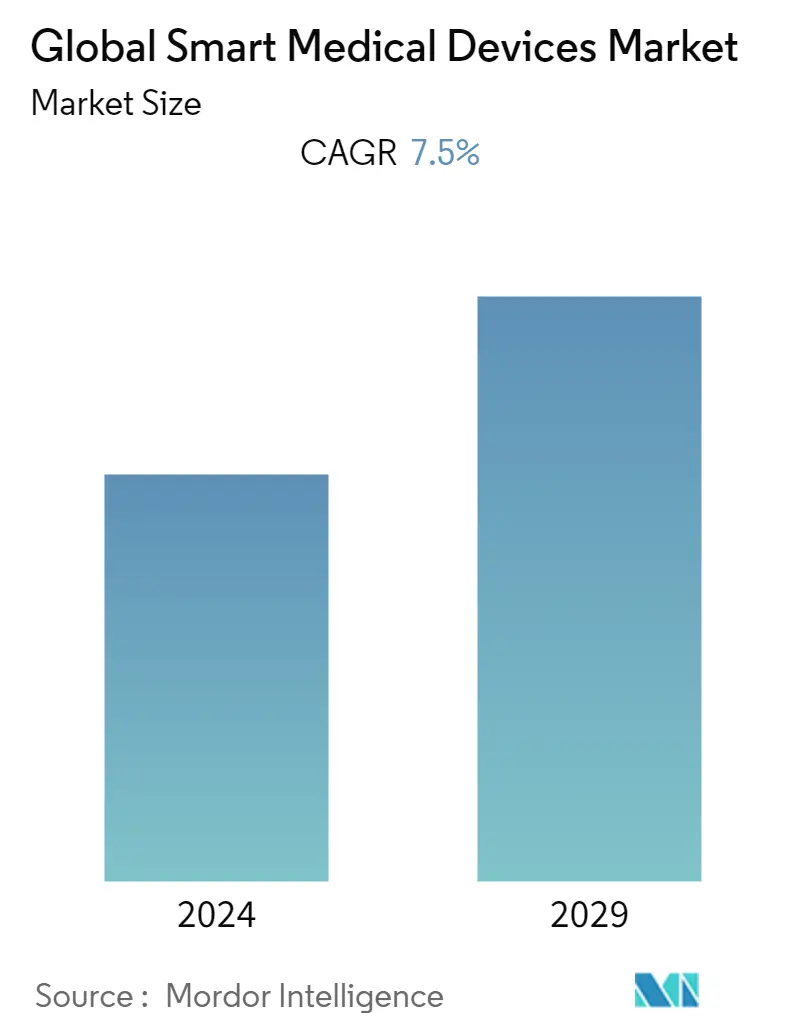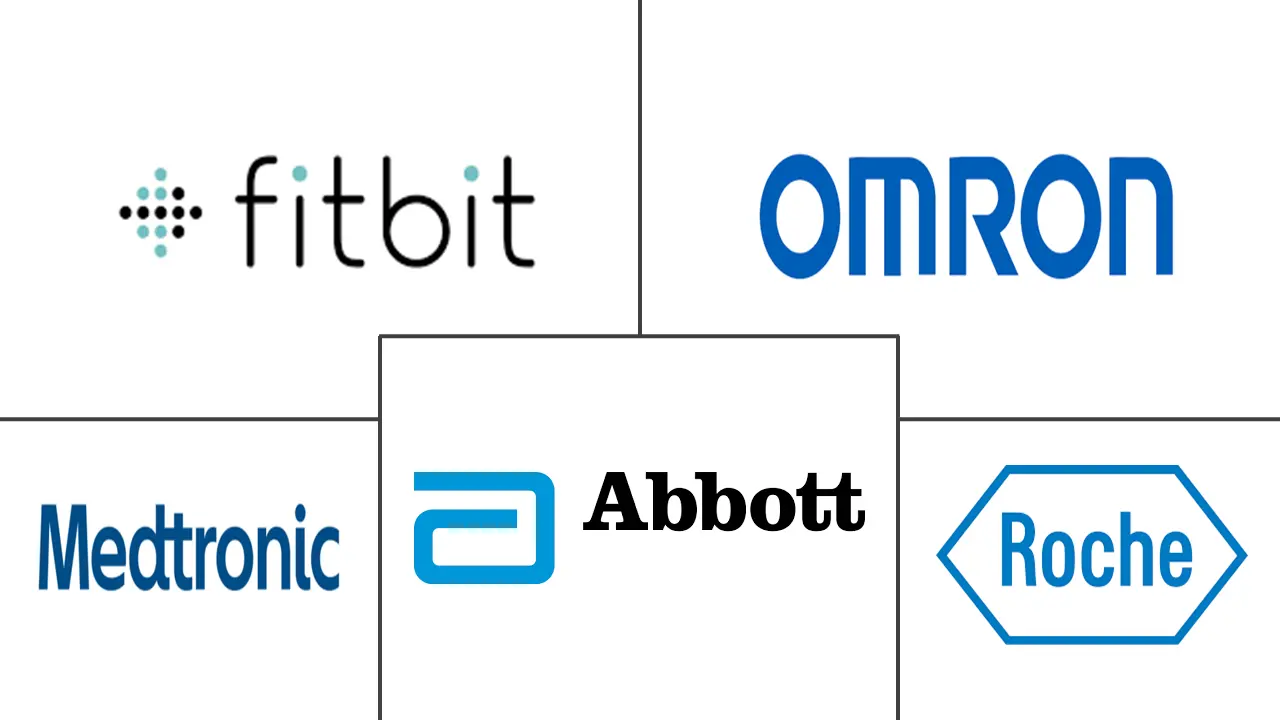Market Size of Global Smart Medical Devices Industry

| Study Period | 2019 - 2029 |
| Base Year For Estimation | 2023 |
| Forecast Data Period | 2024 - 2029 |
| CAGR | 7.50 % |
| Fastest Growing Market | Asia Pacific |
| Largest Market | North America |
Major Players
*Disclaimer: Major Players sorted in no particular order |
Smart Medical Devices Market Analysis
The smart medical devices market is expected to register a CAGR of 7.5% during the forecast period (2022-2027).
During the COVID-19 pandemic, smart medical devices, including sensors and nano-bio sensors, have gained considerable importance due to contactless-based healthcare diagnosis. The wearable sensors can measure vital signals of the human body such as heart rate, blood pressure, skin coloration, body temperature, respiratory rate, sleep duration, and body motion. In April 2021, Researchers at Imperial College London and the University of Freiburg reported that they were developing wearable devices that could be used to develop a network of health data about a patient, allowing for early diagnosis of COVID-19 even when the patient is asymptomatic.
The smart medical devices market is driven by the rising demand for smartphone-compatible and wireless medical devices, technological advancements in devices, and rising awareness and focus on fitness.
The demand for wearable medical devices, such as sensors, ECG devices, and smartwatches with fitness trackers has increased because these devices are easy to use, and interpreting the results doesn't need great expertise. Thus, the user can keep track of their health condition by monitoring their vital signs without the need to visit clinics/hospitals frequently. This feature of wearable medical devices is expected to witness an increased acceptance among the geriatric population.
Additionally, the data updated by United Nations in its World Population Prospectus 2022 published in July 2022 mentioned that Europe and Northern America had the oldest population in 2022, with almost 19% population aged 65 or over. In addition, as per the United Nations Department of Economic and Social Affairs: Population Division data updated in July 2022 shows that as of January 2020, 15.6% of the total population in the Netherlands are of age 65 or more, which were 2,686,541 persons above 64 years old were there in the country among which 1,167,896 were males, and 1,518,645 were females.
The measurement of blood glucose levels, heart rate, and ECG require the users to use simple navigation buttons on the device or control the settings through a connect mobile application, thus making the use of these devices comfortable for the elderly and people with low technology acumen.
The key players have invested heavily in the research and development of new and existing wearable medical devices. For instance, Apple has launched Watch Series 1,2,3,4,5, and 6 over the past few years. The technological advancements can be witnessed through the features available in series 1 to series 6. Apple watch series 1, 2, and 3 possess features such as an optical heart sensor (high heart rate notification), optical heart sensor (low heart rate notification), and optical heart sensor (irregular rhythm notification).
The lifestyle of the people across developing countries such as India, South Africa, etc., are making them fall prey to the diseases, and hence, efforts are being made by these people to cope with such diseases. Therefore, it is believed that the market for advanced smart medical devices will grow in the coming future.
Smart Medical Devices Industry Segmentation
As per the scope of the report, smart medical devices are equipped with the technology for ease of monitoring health or portability of the same, which enables a person to carry it anywhere.
The smart medical devices market is segmented by product type (diagnostic and monitoring and therapeutic devices), end user (hospitals/clinics, home-care settings, and others), and geography (North America, Europe, Asia-Pacific, the Middle-East and Africa, and South America). The Market report also covers the estimated market sizes and trends of 17 countries across major regions globally. The report offers values (in USD million) for the above segments.
| By Product Type | ||||||||
| ||||||||
|
| By End User | |
| Hospitals/Clinics | |
| Home-care Setting | |
| Others |
| Geography | ||||||||
| ||||||||
| ||||||||
| ||||||||
| ||||||||
|
Global Smart Medical Devices Market Size Summary
The smart medical devices market is experiencing significant growth, driven by the increasing demand for smartphone-compatible and wireless medical devices, alongside technological advancements in the field. The COVID-19 pandemic has further accelerated the adoption of these devices, as they enable contactless healthcare diagnostics. Wearable sensors, including smartwatches and fitness trackers, have become popular for monitoring vital signs such as heart rate, blood pressure, and body temperature, offering users the convenience of tracking their health without frequent clinic visits. This trend is particularly beneficial for the geriatric population, who may have limited technological expertise but can easily navigate these user-friendly devices. The market is also witnessing substantial investments in research and development by key players, leading to the introduction of innovative products that cater to the evolving needs of consumers.
Regionally, North America holds the largest market share, supported by high standards of healthcare facilities and favorable policies that make advanced medical devices accessible to a broad population. The region's early adoption of technological advancements and the presence of major market players contribute to its dominant position. The increasing prevalence of chronic diseases, such as coronary heart disease, further drives the demand for smart medical devices in this region. Globally, the market is moderately competitive, with a few companies holding significant market share while new entrants emerge due to technological advancements and increased research and development expenditure. Companies like Apple, Medtronic, and Fitbit are at the forefront, continuously launching innovative products to meet the growing demand for smart medical devices.
Global Smart Medical Devices Market Size - Table of Contents
-
1. MARKET DYNAMICS
-
1.1 Market Overview
-
1.2 Market Drivers
-
1.2.1 Rise in Demand for Smartphone-compatible and Wireless Medical Devices
-
1.2.2 Technological Advancement in Devices
-
1.2.3 Rising Awareness and Focus on Fitness
-
-
1.3 Market Restraints
-
1.3.1 High Cost of Devices
-
1.3.2 Patients Privacy Concerns
-
-
1.4 Porter's Five Forces Analysis
-
1.4.1 Threat of New Entrants
-
1.4.2 Bargaining Power of Buyers/Consumers
-
1.4.3 Bargaining Power of Suppliers
-
1.4.4 Threat of Substitute Products
-
1.4.5 Intensity of Competitive Rivalry
-
-
-
2. MARKET SEGMENTATION
-
2.1 By Product Type
-
2.1.1 By Diagnostic and Monitoring
-
2.1.1.1 Blood Glucose Monitors
-
2.1.1.2 Heart Rate Monitors
-
2.1.1.3 Pulse Oximeters
-
2.1.1.4 Blood Pressure Monitors
-
2.1.1.5 Breath Analyzer
-
2.1.1.6 Other Diagnostic Monitoring Products
-
-
2.1.2 By Therapeutic Devices
-
2.1.2.1 Portable Oxygen Concentrators and Ventilators
-
2.1.2.2 Insulin Pumps
-
2.1.2.3 Hearing Aid
-
2.1.2.4 Other Therapeutic Devices
-
-
-
2.2 By End User
-
2.2.1 Hospitals/Clinics
-
2.2.2 Home-care Setting
-
2.2.3 Others
-
-
2.3 Geography
-
2.3.1 North America
-
2.3.1.1 United States
-
2.3.1.2 Canada
-
2.3.1.3 Mexico
-
-
2.3.2 Europe
-
2.3.2.1 Germany
-
2.3.2.2 United Kingdom
-
2.3.2.3 France
-
2.3.2.4 Italy
-
2.3.2.5 Spain
-
2.3.2.6 Rest of Europe
-
-
2.3.3 Asia-Pacific
-
2.3.3.1 China
-
2.3.3.2 Japan
-
2.3.3.3 India
-
2.3.3.4 Australia
-
2.3.3.5 South Korea
-
2.3.3.6 Rest of Asia-Pacific
-
-
2.3.4 Middle-East and Africa
-
2.3.4.1 GCC
-
2.3.4.2 South Africa
-
2.3.4.3 Rest of Middle-East and Africa
-
-
2.3.5 South America
-
2.3.5.1 Brazil
-
2.3.5.2 Argentina
-
2.3.5.3 Rest of South America
-
-
-
Global Smart Medical Devices Market Size FAQs
What is the current Global Smart Medical Devices Market size?
The Global Smart Medical Devices Market is projected to register a CAGR of 7.5% during the forecast period (2024-2029)
Who are the key players in Global Smart Medical Devices Market?
Fitbit Inc., Medtronic Plc, F. Hoffmann-La Roche Ltd, Omron Corporation and Abbott Laboratories are the major companies operating in the Global Smart Medical Devices Market.

